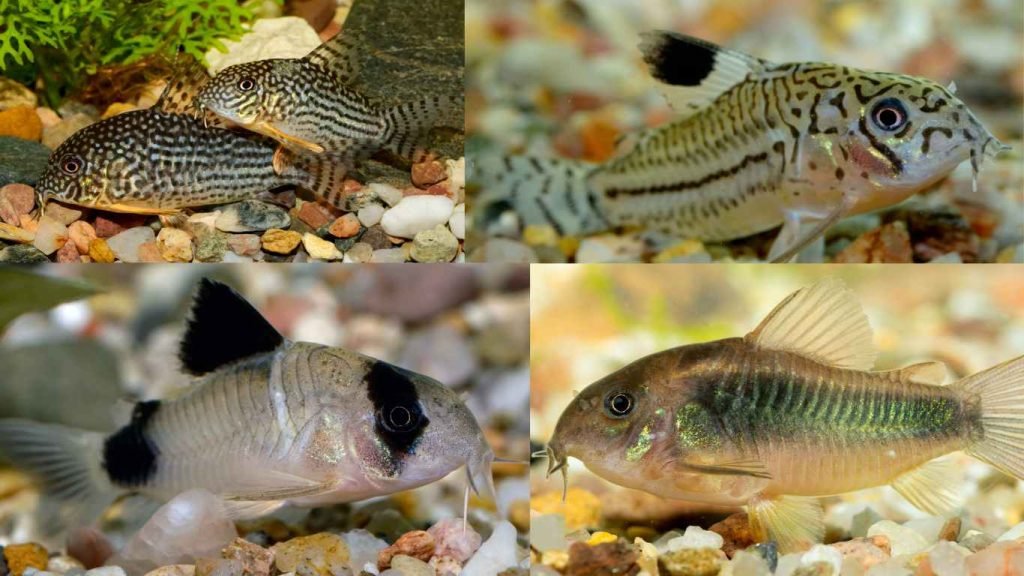Welcome to our guide on the diverse types of Corydoras catfish. With over 160 species, the Corydoras genus offers a wide range of catfish breeds to choose from. Whether you are a beginner or an experienced aquarium enthusiast, these fascinating fish make a fantastic addition to any freshwater tank. Let’s dive into the world of Corydoras catfish and discover the different varieties available.
Aquatic Insights to Corydoras Catfish:
Bronze Corydoras (Corydoras aeneus)
The Bronze Corydoras, also known as Green Corydoras, is the most common and popular species of Corydoras. It has a distinctive bronze shine with a green tint in certain lights. Bronze Corydoras are easy to find and relatively inexpensive. They are also known for their ease of breeding.
Characteristics of Bronze Corydoras
Here are some key characteristics of Bronze Corydoras:
- Appearance: They have a bronze color with a green tint, and their bodies are covered in small scales.
- Size: Adult Bronze Corydoras can grow up to 2.5 inches in length.
- Behavior: Bronze Corydoras are peaceful and get along well with other fish in a community tank.
- Habitat: They are native to South America and can be found in rivers and streams.
- Diet: Bronze Corydoras are omnivorous and will eat a variety of foods, including sinking pellets, flakes, and frozen foods.
Overall, Bronze Corydoras are a great choice for both beginners and experienced aquarium enthusiasts. Their striking appearance and ease of care make them a popular choice for freshwater aquariums.
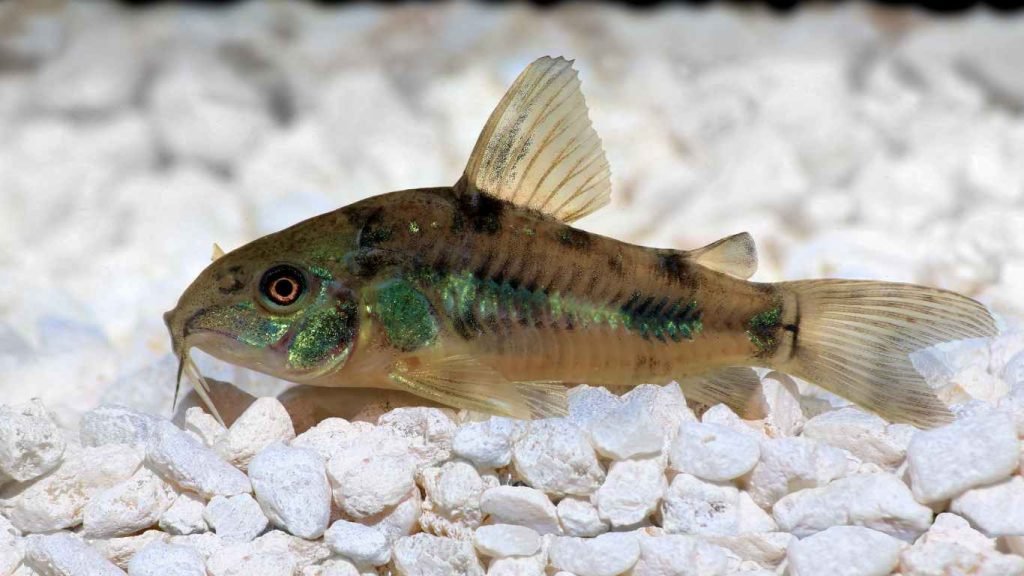
Peppered Corydoras (Corydoras paleatus)
The Peppered Corydoras, also known as Corydoras paleatus, is a popular species of Corydoras catfish. While it may have a duller and less prominent pattern compared to other varieties, its unique appearance still captures the attention of aquarium enthusiasts.
Peppered Corydoras are considered hardy and are often recommended for beginners in the hobby. They can adapt well to various water conditions, making them relatively easy to care for. These catfish are known to be peaceful and social, making them great companions for community tanks.
One of the fascinating traits of Peppered Corydoras is their ability to reproduce easily. Their natural breeding habits usually involve the female laying eggs on the leaves of plants or other surfaces. The male then fertilizes the eggs, allowing them to develop into fry. Breeding Peppered Corydoras can be a rewarding experience for aquarists looking to expand their fish population.
If you’re considering adding Peppered Corydoras to your aquarium, try creating a natural environment for them with plenty of plants, hiding spots, and soft substrates. Providing a varied diet consisting of high-quality flakes, pellets, and live or frozen foods will ensure their nutritional needs are met.
| Peppered Corydoras (Corydoras paleatus) | |
|---|---|
| Species | Corydoras paleatus |
| Common Names | Peppered Cory, Paleatus Cory, Blue Leopard Cory |
| Origin | South America (Argentina, Brazil, Uruguay) |
| Size | 2-3 inches (5-7.5 cm) |
| Temperament | Peaceful, social |
| Water Conditions | pH 6.0-7.5, temperature 72-79°F |
| Diet | Omnivorous (flakes, pellets, live/frozen foods) |
Overall, Peppered Corydoras are an excellent choice for aquarists of all skill levels. Their resilience, sociability, and unique appearance make them a captivating species to keep in your aquarium.

Sterba’s Corydoras (Corydoras sterbai)
Sterba’s Corydoras, also known as Sterbai Corydoras, is highly prized for its striking markings. It has beautiful, contrasting patterns that make it a visually appealing addition to an aquarium. Sterba’s Corydoras can tolerate higher water temperatures compared to other species, making them compatible with fish that prefer warmer environments.
These catfish are native to the upper Paraná River Basin in South America. They were first described by the German aquarist Hans-Georg Evers in 1990 and were named in honor of Dr. Rüdiger R. E. Sterba, an ichthyologist.
Sterba’s Corydoras are relatively small, reaching an average size of 2.5 to 3 inches (6 to 8 cm) in length. They have an elongated body shape and are known for their bright orange or red coloration. The base color of their body is typically dark brown or black, covered with small white spots. These spots are more pronounced on the head and dorsal fin, creating a captivating contrast.
Moreover to their attractive appearance, Sterba’s Corydoras are peaceful and social fish. They are known to be active during the day and enjoy swimming in the mid to lower levels of the tank. It is recommended to keep them in groups of at least 6 individuals to ensure their well-being.
“Sterba’s Corydoras is a stunning species that adds a touch of elegance to any aquarium. Their contrasting patterns and graceful movements make them a favorite among fishkeepers.” – Aquarium Enthusiast Magazine
When it comes to tank setup, Sterba’s Corydoras prefer a well-decorated aquarium with plenty of hiding places. They will appreciate the presence of live plants, driftwood, and rocks. Substrate should be fine-grained to mimic their natural habitat. These catfish are also sensitive to water quality, so regular water changes and proper filtration are essential to keep them healthy.
As omnivores, Sterba’s Corydoras will readily accept a variety of foods. A balanced diet should consist of high-quality sinking pellets, flakes, frozen or live foods such as bloodworms, brine shrimp, and daphnia. It is important to ensure that the food provided is suitable for their small mouths.

Shrimp Pellets Sinking Food for Corydoras
If you’re considering adding Sterba’s Corydoras to your tank, it is important to choose fish with vibrant colors and no signs of illness. They can live for up to 10 years with proper care and a suitable environment.
Overall, Sterba’s Corydoras are a favored species among aquarists for their stunning appearance, peaceful nature, and ability to tolerate higher water temperatures. Their unique markings and captivating behavior make them a delightful addition to any community aquarium.
| Species Name | Common Names | Adult Size | Temperature Range | pH Range | Diet |
|---|---|---|---|---|---|
| Corydoras sterbai | Sterba’s Corydoras, Sterbai Corydoras | 2.5 to 3 inches (6 to 8 cm) | 72°F to 79°F (22°C to 26°C) | 6.0 to 7.8 | Omnivorous – Sinking pellets, flakes, frozen/live foods |
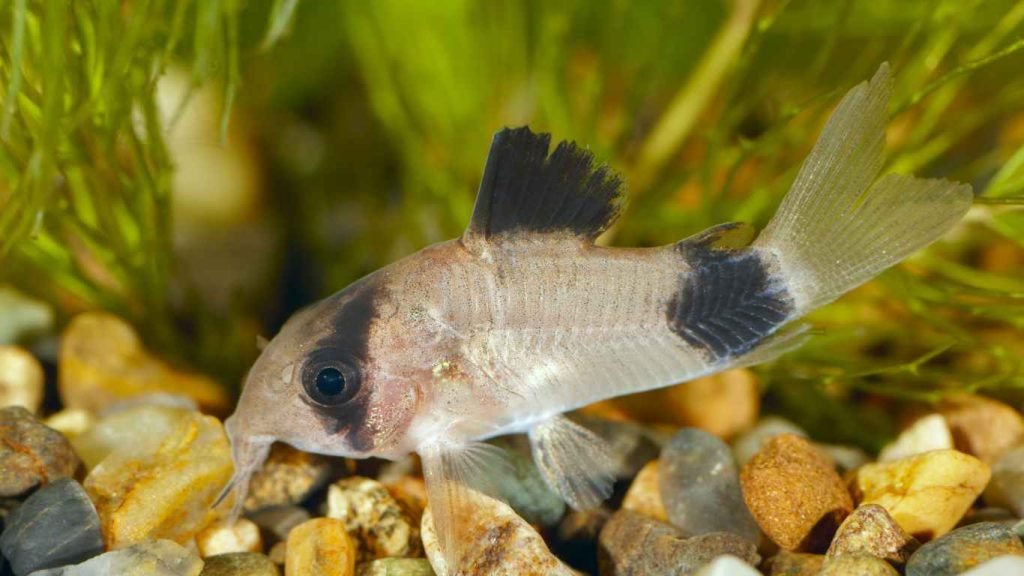
Panda Corydoras (Corydoras panda)
The Panda Corydoras gets its name from its cute panda-like markings. These fish have black patches around their eyes, resembling the appearance of a panda. Panda Corydoras are highly sought after for their unique and adorable appearance. However, they are often considered less hardy and require more experienced care compared to other species.
“The Panda Corydoras is like a miniature version of the beloved panda. Its distinctive markings make it a standout in any aquarium.”
If you’re looking to add a touch of cuteness to your aquarium, the Panda Corydoras is a fantastic choice. These small catfish have a playful and adorable appearance, thanks to their panda-like markings. They sport black patches around their eyes, resembling the distinct features of a real panda. The striking resemblance to this beloved bear is what makes the Panda Corydoras highly sought after among aquarium enthusiasts.
While their appearance may be captivating, it’s important to note that Panda Corydoras require a bit more attention and care compared to other species. They are often considered less hardy, meaning they are more sensitive to changes in water conditions. To ensure their well-being, it’s crucial to maintain a stable and well-maintained aquarium environment.
Experienced hobbyists who are familiar with the intricacies of water parameters and tank maintenance will find the Panda Corydoras to be a rewarding addition to their collection. By providing the necessary care and attention, you can enjoy the delightful antics of these adorable catfish, bringing a touch of charm to your aquarium.
Key Features of Panda Corydoras:
- Distinctive black patches around the eyes resembling a panda
- Playful and adorable demeanor
- Requires experienced care and attention
| Feature | Description |
|---|---|
| Scientific Name | Corydoras panda |
| Origin | South America: Amazon River basin, Brazil, Peru |
| Size | 2-2.5 inches (5-6.5 cm) |
| Tank Size | 20 gallons or more |
| Water Conditions | Temperature: 72-79°F (22-26°C); pH: 6.0-7.5; Hardness: 2-15 dGH |
| Diet | Omnivorous, prefers sinking pellets or tablets, occasional live or frozen foods |
| Compatibility | Peaceful, suitable for community tanks |

Bandit Corydoras (Corydoras metae)
Bandit Corydoras, also known as Metae Corydoras, share some similarities in markings with the Panda Corydoras. However, they display a more pronounced black coloration on their backs, resulting in a distinctive appearance. These catfish species are known for their peaceful nature, making them an excellent choice for community tanks. Bandit Corydoras are highly social and often seen in groups known as shoals, adding a lively dynamic to any aquarium.
Caring for Bandit Corydoras
Providing suitable care for Bandit Corydoras is essential to their well-being. Consider the following care guidelines to ensure a healthy and happy habitat:
- Water Temperature: Maintain a temperature range of 72-78°F (22-26°C), which replicates their natural habitat.
- Water Quality: Regularly monitor and maintain optimal water parameters, including pH levels between 6.5 and 7.5 and moderate hardness.
- Tank Setup: Provide a well-planted aquarium with hiding spots, such as caves, driftwood, or rocks, to create a comfortable environment for the Bandit Corydoras.
- Diet: Offer a balanced diet consisting of high-quality fish flakes, pellets, and occasional live or frozen foods like bloodworms or brine shrimp.
- Compatibility: Bandit Corydoras are compatible with most peaceful community fish, such as tetras, rasboras, and dwarf cichlids.
Caring for Bandit Corydoras involves maintaining suitable water conditions and providing an enriching environment for these sociable catfish species.

Julii Corydoras (Corydoras julii)
Julii Corydoras, often confused with the Three Stripe Corydoras, is prized for its attractive appearance. These fish have beautiful markings and are highly sought after by enthusiasts. Julii Corydoras are generally less common in pet stores compared to other species, but they require similar care and can thrive in community aquariums.
One of the distinguishing features of Julii Corydoras is its pattern of dark spots and speckles on a light background. These markings resemble intricate lace patterns, adding elegance to any aquarium. The combination of white, black, and gray colors creates a stunning visual impact when these fish swim gracefully in the water.
Like other Corydoras catfish, Julii Corydoras are peaceful and social creatures. They enjoy shoaling and should be kept in groups of at least six individuals to ensure their well-being and reduce stress. They are compatible with other peaceful fish species that favor similar water conditions.
When it comes to care, Julii Corydoras require a well-maintained aquarium with clean water and appropriate hiding places. Provide them with a sandy substrate to mimic their natural habitat, as they are known to sift through the bottom foraging for food. A balanced diet consisting of high-quality pellets, live or frozen foods, and occasional vegetables will help keep them healthy and vibrant.
| Difficulty Level | Temperature | pH Level | Diet |
|---|---|---|---|
| Easy | 70°F – 79°F (21°C – 26°C) | 6.0 – 7.5 | High-quality pellets, live or frozen foods, occasional vegetables |
Julii Corydoras are a delightful addition to any community aquarium. Their captivating appearance and peaceful nature make them a favorite among aquarists. Ensure proper care and a suitable environment, and you will be rewarded with the charming presence of Julii Corydoras in your aquatic world.
Small Types of Cory Catfish
When it comes to small catfish for your aquarium, there are a few varieties of Corydoras that are the perfect fit for smaller fish tanks. These tiny yet captivating catfish will bring life and charm to your aquatic ecosystem.
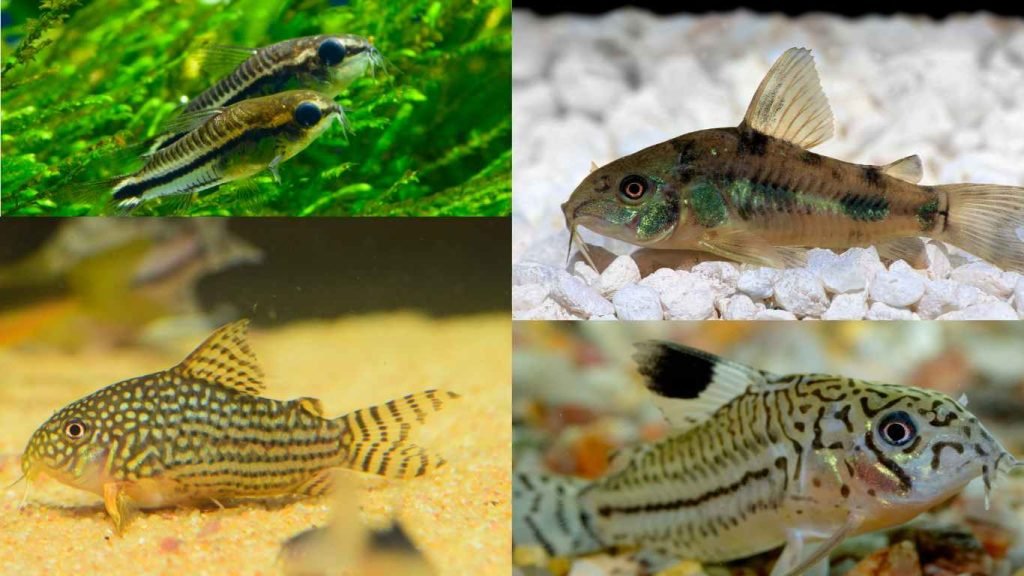
Pygmy Corydoras (Corydoras pygmaeus)
If you’re looking for a miniature catfish that stays small, the Pygmy Corydoras is an excellent choice. With males reaching around 0.75 inches and females rarely measuring over 1 inch, these petite catfish are adorable additions to any aquarium. Their small size allows them to explore even the tightest corners of your tank, making them a joy to watch.
Salt and Pepper Corydoras (Corydoras habrosus)
For a dash of unique style in your aquarium, consider the charming Salt and Pepper Corydoras. Growing up to 1.4 inches in length, these catfish display a distinctive salt and pepper pattern on their bodies, adding a touch of elegance to your tank. Their small size doesn’t diminish their playfulness, as they love to swim and explore their environment.
Dwarf Corydoras (Corydoras hastatus)
Similar in size to the Pygmy Corydoras, Dwarf Corydoras measure less than 1 inch and are known for their small stature. These tiny catfish possess a curious and lively nature that will bring energy to your aquarium. With their playful antics and beautiful appearance, Dwarf Corydoras are a delightful addition to any small fish tank.
With these small types of Corydoras catfish, you can create a captivating miniature underwater world in your smaller fish tanks. These tiny catfish species will thrive in compact environments while adding personality and visual appeal to your aquarium. Just remember to provide them with proper care and a suitable habitat to ensure their well-being.
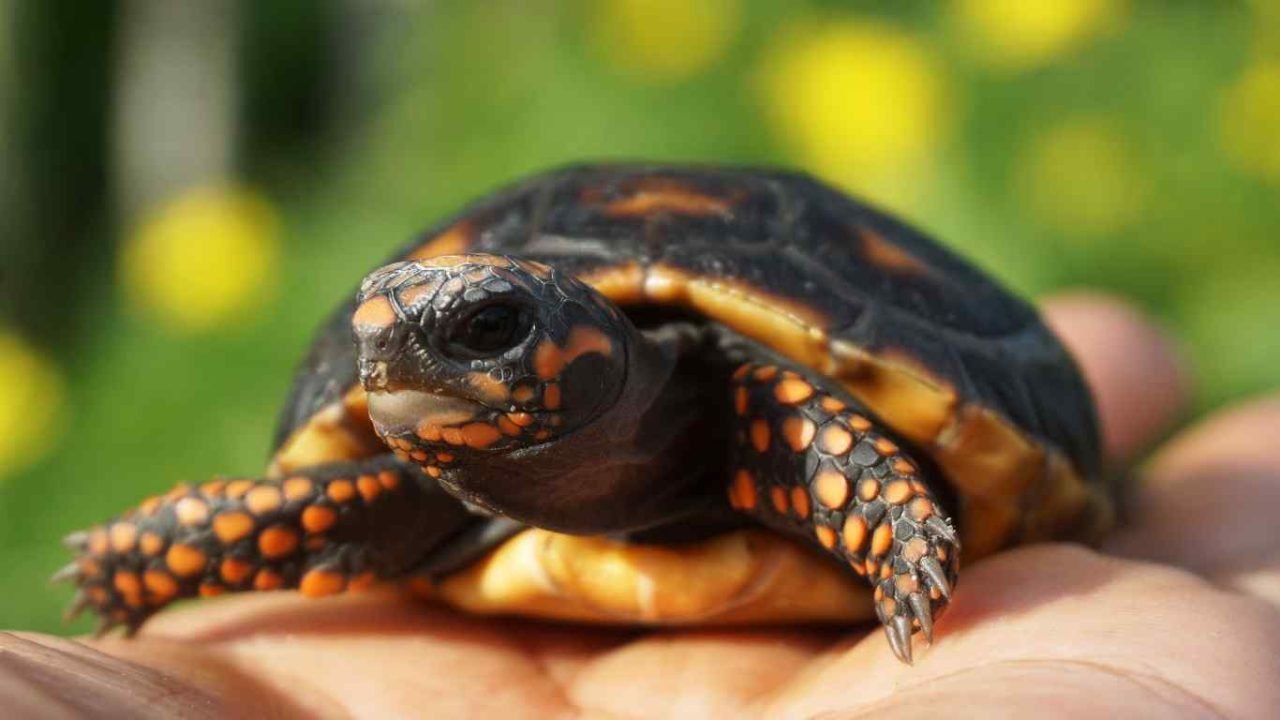
Join Our GeoZoo Family
Subscribe to our Newsletter
Final Remarks
Corydoras catfish offer a diverse and popular selection of fish varieties, making them a favorite among aquarium enthusiasts. Whether you’re captivated by the striking markings of Sterba’s Corydoras or the adorable patterns of the Panda Corydoras, there is a Corydoras species that will capture your heart.
To ensure the well-being and enjoyment of these finned friends in your aquarium, it is crucial to provide them with proper care and maintenance. From regular water changes and appropriate feeding to maintaining suitable tank parameters, creating a healthy environment is essential.
Corydoras catfish bring more than just beauty to your freshwater tank. With their vibrant personalities and captivating appearances, they add a dynamic and lively element to any aquatic ecosystem. Their playful nature and engaging behavior make them the perfect companions for both experienced and novice fishkeepers alike.
In the end, whether you choose Sterba’s Corydoras, the charming Panda Corydoras, or one of the many other captivating species, adding Corydoras catfish to your aquarium is a wonderful way to enhance your aquatic experience. Their unique characteristics, captivating appearances, and ease of care make them a fantastic choice for any freshwater tank. So dive in and explore the world of Corydoras catfish – your aquarium will thank you!
FAQ
What are the different types of Corydoras catfish?
Some popular types of Corydoras catfish include Bronze Corydoras, Peppered Corydoras, Sterba’s Corydoras, Panda Corydoras, Bandit Corydoras, and Julii Corydoras.
What is the most common species of Corydoras catfish?
The Bronze Corydoras, also known as the Green Corydoras, is the most common and popular species of Corydoras.
Are Peppered Corydoras suitable for beginners?
Yes, Peppered Corydoras are considered hardy and are often recommended for beginners. They are known to be easy to care for and reproduce.
What makes Sterba’s Corydoras unique?
Sterba’s Corydoras, also known as Sterbai Corydoras, has striking markings and beautiful, contrasting patterns that make it visually appealing.
What are the distinguishing features of Panda Corydoras?
Panda Corydoras have black patches around their eyes, resembling the appearance of a panda. They are highly sought after for their unique and adorable appearance.
Are Bandit Corydoras suitable for community tanks?
Yes, Bandit Corydoras, also known as Metae Corydoras, are peaceful and make great additions to community tanks. They are known for their social nature and are often found in shoals.
What is special about Julii Corydoras?
Julii Corydoras, often confused with Three Stripe Corydoras, have beautiful markings and are highly sought after for their attractive appearance.
What are some small types of Corydoras catfish for smaller tanks?
Some small types of Corydoras catfish include Pygmy Corydoras, Salt and Pepper Corydoras, and Dwarf Corydoras. These catfish stay small in size.

